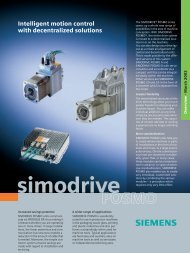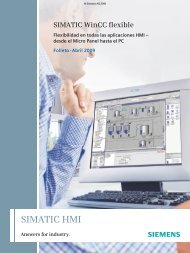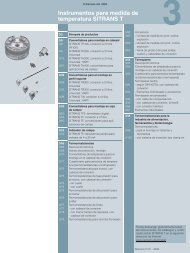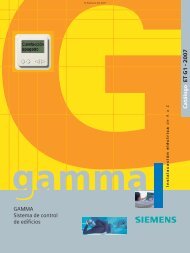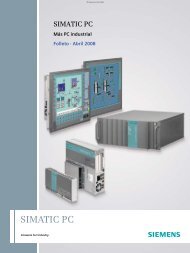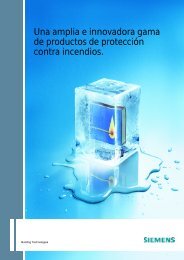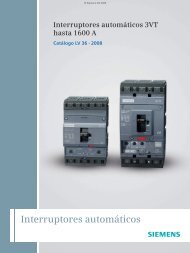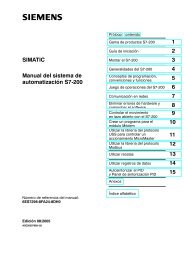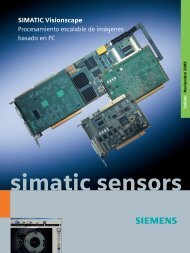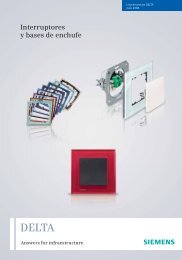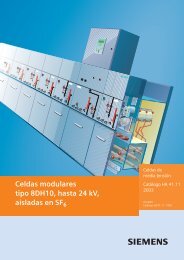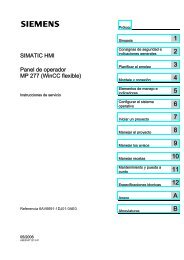You also want an ePaper? Increase the reach of your titles
YUMPU automatically turns print PDFs into web optimized ePapers that Google loves.
© Siemens AG 2007<br />
Appendix<br />
Glossary<br />
Interlock of opposing contacts<br />
(see also IEC/EN 60947-1; 2.4.11 / IEV 441-16-12)<br />
Isolating function<br />
(see also IEC/EN 60947-1; 2.1.19)<br />
Losses<br />
(see also IEV 151-03-18)<br />
Mechanical shock resistance<br />
Minimum command time<br />
Opening delay<br />
(see also IEV 441-17-36)<br />
Overvoltage category<br />
(see also IEC/EN 60947-1; 2.5.60)<br />
Pollution degree<br />
(see also IEC/EN 60947-1; 5.5.58)<br />
Positive opening<br />
(see also IEC/EN 60947-1; 2.4.10 / IEV 441-16-11)<br />
This ensures that the auxiliary contacts of a switching device are<br />
always in the switching position corresponding to the open or closed<br />
position of the main contacts. The contacts of contactors are interlocked<br />
opposing contacts, provided they are mechanically linked in<br />
such a way as to ensure that normally closed contacts and normally<br />
open contacts can never be closed simultaneously. This arrangement<br />
must also ensure that minimum contact separation of 0.5 mm is maintained<br />
over the entire endurance of the device, even during a fault<br />
(e.g. welding of one contact). The pertinent German Trade Association<br />
requires the use of contactors with interlocked opposing contacts for<br />
control systems on power presses in the metal processing industry.<br />
Equipment is deemed to possess this isolating function provided their<br />
switching contacts, when in the open position, achieve the separation<br />
distance prescribed for the isolation of electrical circuits, and their<br />
creepage paths and clearance distances are of the required size. The<br />
power supply to the entire installation or a section of the installation can<br />
thus be cut off for safety reasons, e.g. during maintenance.<br />
The difference between the input power and the output power of a<br />
device. The main type of loss in electrical equipment and operating<br />
media in power distribution is current heat loss.<br />
The capacity of an equipment to withstand pulse-like motions without<br />
changing its operating status or sustaining damage. No contact lifting<br />
must take place on devices in the On position, the main contacts must<br />
not knock against one another in the Off position. A protective switch<br />
must not trip, and control circuit switches must not change their switching<br />
status.<br />
Minimum period of time for which a trip-initiating factor (control pulse,<br />
short-circuit current) must be present in order to effect the corresponding<br />
reaction, e.g. the short-circuit duration necessary to initiate tripping.<br />
The interval of time between the specified instant of initiation of the<br />
opening operation and the instant when the arcing contacts have separated<br />
in all poles. The opening delay is the sum of the tripping delay<br />
and the inherent delay of the contacts.<br />
Conventional number for prospective overvoltages as might be<br />
caused, for example, as a result of lightning or switching processes.<br />
The overvoltage category applicable to industrial switchgear is III. The<br />
applicability of switchgear according to the overvoltage categories is<br />
as follows:<br />
• Overvoltage category IV:<br />
Use directly at the termination point of the installation (directly affected<br />
by any lightning), e.g. at an overhead line connection point.<br />
• Overvoltage category III:<br />
Operating media with special requirements as to the serviceability for<br />
connection in fixed installations which are protected by overvoltage diversion<br />
measures, e.g. switches in low-voltage distribution systems or<br />
in control systems for industrial use.<br />
• Overvoltage category II:<br />
Power consumers for connection to fixed installations, e.g. household<br />
appliances, electrical tools.<br />
• Overvoltage category I:<br />
Operating media for connection to circuits with overvoltage protection<br />
schemes, e.g. electronic devices.<br />
Conventional number for the prospective quantities of conductive dust<br />
and humidity, which can lead to a reduction in the control circuit reliability<br />
of a switching device. The pollution degree is defined by the following<br />
factors:<br />
• Pollution degree 1:<br />
No pollution or only dry, non-conductive pollution occurs. The pollution<br />
has no effect on the control circuit reliability.<br />
• Pollution degree 2:<br />
Usually, only non-conductive pollution. However, transient conductivity<br />
through condensation is to be expected.<br />
• Pollution degree 3: (switchgear for industrial use)<br />
Conductive pollution or dry, non-conductive pollution, which is rendered<br />
conductive through condensation.<br />
• Pollution degree 4:<br />
The pollution leads to long-term conductivity, e.g. pollution through<br />
conductive dust, rain or snow.<br />
An opening operation which ensures that the main contacts of a switching<br />
device have attained the open position when the actuator is in the<br />
Off position.<br />
6<br />
Siemens LV 70 · 2006<br />
6/3




